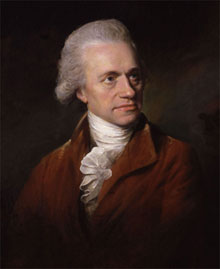
Portrait by Lemuel Francis Abbott, oil on canvas, 1785. Image courtesy the National Portrait Gallery, London.
Herschel
Frederick William Herschel (15 November 1738 – 25 August 1822) was the first to conclude that the sun was in motion. From his own observations and astronomical records he concluded that the stars were moving apart in one region of space and coming closer together in another. The sun therefore could not be at the centre of the universe, in agreement with the speculation of Nicholas of Cusa and Bruno, but now placed on a definite observational basis.
Herschel was also the first to systematically study and catalogue binary star systems. He proposed that binary (or ‘double’) stars were pairs of stars in orbit about each other, and that the universality of Newton’s law of gravity could thereby be tested in application to bodies beyond the solar system. He believed, as did Bruno, that other planets were inhabited, including the planets of the solar system, and that even the sun was inhabited. He made notable astronomical discoveries of bodies within the solar system, among them the planet Uranus, two of its maor moons, Titania and Oberon, and two of the minor moons of Saturn. He was also the first to discover the existence of infrared radiation. He published three major star catelogues: the Catalogue of One Thousand New Nebulae and Clusters of Stars (1786), Catalogue of a Second Thousand New Nebulae and Clusters of Stars (1789) and the Catalogue of 500 New Nebulae ... (1802). The last, as the name suggests, documented his extensive discoveries of extended stellar objects, the great majority of which were eventually established to be extra-galactic by Hubble’s observations of Cepheid variables (or ‘standard candles’) within them.
Born in Hanover, Germany, Herschel was a noted musician: he became resident in England at the age of 19 following the defeat of the Hanoverian guards, in which he played as oboist, by the French in1757. In England he played in numerous orchestras and military bands and composed several symphonies. His interests in astronomy date from the early 1770s, when he began building his own reflecting telescopes, including lens design and grinding.
Links
Project Guttenburg: the Story of the Herschels, a Family of Astronomers >
